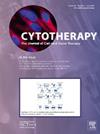背景膜显微镜,一种检测细胞治疗产品中污染颗粒的新技术。
IF 3.7
3区 医学
Q2 BIOTECHNOLOGY & APPLIED MICROBIOLOGY
引用次数: 0
摘要
背景,目的使用流式细胞术等标准技术来区分细胞治疗产品中不同的亚可见颗粒(SVP)已被证明具有挑战性。这部分是由于细胞治疗产品本身对不可见粒子群的贡献。最近FDA发布了关于Kymriah®中木材,纤维素,黄铜和钢铁颗粒污染的483表格,归因于冷冻保存袋。这突出表明需要一种新的方法来确定细胞治疗中的亚可见颗粒。背景膜成像(BMI)和侧面照明膜成像(SIMI)的结合,暗场显微镜的一种形式,提供了独特的和明确的见解,不同的粒子种类的性质。生物和非生物(塑料,木材,金属)颗粒的存在可以使用这种成像方法的组合来识别和计数。与生物材料相比,非生物材料表现出强烈的SIMI特征,部分原因是在过滤膜上检查时的相对折射率和刚性。在本研究中,我们分别使用96孔板和24孔白膜板,演示了组合成像模式在两个负载体积为40uL和400uL的CAR - T细胞混合的不同非生物材料的鉴定。在96孔黑色膜板上用适当的荧光染料染色,可简便地测定蛋白质、DNA或脂质等生物物质。用适当的荧光染料在黑色膜板上染色,可方便地测定蛋白质、DNA或脂质等生物物质。结论该方法为快速高通量测定蛋白质聚集体、细胞团块、细胞结合微球、活细胞群的鉴定提供了额外的实用价值。本文章由计算机程序翻译,如有差异,请以英文原文为准。
Backgrounded Membrane Microscopy, a novel technique for the determination of contaminating particles in cell therapy products.
Background & Aim
Distinguishing between different subvisible particle (SVP) species within a cell therapy product has proven challenging using standard techniques such as flow cytometry. This is in part due to the cell therapy product itself contributing to the subvisible particle population. This has been exemplified by the recent FDA issuance of a Form 483 concerning particle contamination in Kymriah® with wood, cellulose, brass, and steel, attributed to the cryopreservation bags. This has highlighted a need for a new approach in the determination of sub-visible particles within cell therapies.
Methodology
The combination of Backgrounded Membrane Imaging (BMI) and Side Illumination Membrane Imaging (SIMI), a form of darkfield microscopy, provides unique and definitive insights into the nature of different particle species. The presence of biological and non-biological (plastic, wood, metal) particles can be identified and counted using this combination of imaging approaches. Non-biological materials exhibit a strong SIMI signature when compared to biological matter, due in part to the relative refractive index and rigidity when examined on a filter membrane.
Results
Here in, we demonstrate the utility of the combined imaging modes for the identification of different non-biological materials mixed with CAR T cells at two loaded volumes 40uL and 400uL using a 96-well plate and 24-well white membrane plate, respectively.
The specific determination of biological matter, be it protein, DNA or lipid, is facile when stained with appropriate fluorescent dyes on a 96-well black membrane plate. The specific determination of biological matter, be it protein, DNA or lipid, is facile when stained with appropriate fluorescent dyes on black membrane plates.
Conclusion
This approach provides additional utility for the identification of protein aggregates, cell clumps, cell-bound microspheres, viable cell populations within a rapid high-throughput assay.
求助全文
通过发布文献求助,成功后即可免费获取论文全文。
去求助
来源期刊

Cytotherapy
医学-生物工程与应用微生物
CiteScore
6.30
自引率
4.40%
发文量
683
审稿时长
49 days
期刊介绍:
The journal brings readers the latest developments in the fast moving field of cellular therapy in man. This includes cell therapy for cancer, immune disorders, inherited diseases, tissue repair and regenerative medicine. The journal covers the science, translational development and treatment with variety of cell types including hematopoietic stem cells, immune cells (dendritic cells, NK, cells, T cells, antigen presenting cells) mesenchymal stromal cells, adipose cells, nerve, muscle, vascular and endothelial cells, and induced pluripotential stem cells. We also welcome manuscripts on subcellular derivatives such as exosomes. A specific focus is on translational research that brings cell therapy to the clinic. Cytotherapy publishes original papers, reviews, position papers editorials, commentaries and letters to the editor. We welcome "Protocols in Cytotherapy" bringing standard operating procedure for production specific cell types for clinical use within the reach of the readership.
 求助内容:
求助内容: 应助结果提醒方式:
应助结果提醒方式:


